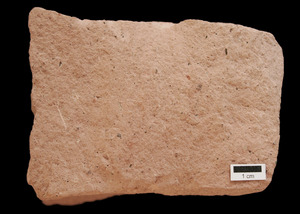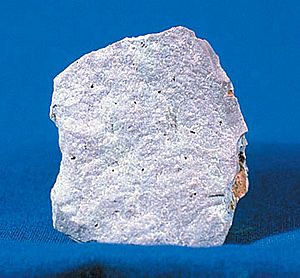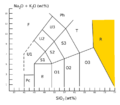Rhyolite facts for kids
| Igneous rock | |
 |
|
| Composition | |
|---|---|
| Felsic: igneous quartz and alkali feldspar (sanidine and sodic plagioclase), biotite and hornblende |
Rhyolite is a very strong type of igneous rock. It forms from volcanic eruptions, making it a volcanic rock. Rhyolite is usually light in color, like pink, gray, or white.
A German geologist named Ferdinand von Richthofen gave this rock its name. He was a famous explorer and scientist.
Contents
What is Rhyolite?
Rhyolite is a common rock found in many places around the world. It forms when magma (molten rock deep inside the Earth) reaches the surface during a volcanic eruption. This magma then cools down very quickly. Because it cools fast, the crystals inside rhyolite are usually very small. Sometimes, they are so tiny you need a microscope to see them!
How Rhyolite Forms
Rhyolite forms from a type of magma that is thick and sticky. This magma is rich in a mineral called silica. When this silica-rich magma erupts from a volcano, it flows out as lava. This lava cools down fast, often on the Earth's surface or just below it. The quick cooling stops large crystals from growing. This is why rhyolite often looks smooth or glassy.
Volcanic Eruptions and Rhyolite
Volcanoes that produce rhyolite lava can be very explosive. This is because the thick, sticky magma traps gases easily. When these gases finally escape, they can cause powerful eruptions. After an eruption, the cooled lava forms rhyolite rock. Sometimes, the lava cools so fast that it forms a natural glass called obsidian.
What is Rhyolite Made Of?
Rhyolite is a felsic rock. This means it has a lot of light-colored minerals. The main minerals in rhyolite are quartz and feldspar.
Key Minerals in Rhyolite
- Quartz: This is a very common mineral. In rhyolite, quartz crystals are often small and clear.
- Feldspar: Rhyolite contains two types of feldspar: sanidine and sodic plagioclase. These minerals also tend to be light-colored.
- Other Minerals: Sometimes, rhyolite can also have small amounts of darker minerals. These include biotite (a type of mica) and hornblende. These minerals give some rhyolite rocks a slightly speckled look.
Where is Rhyolite Found?
Rhyolite is found in areas with past or present volcanic activity. It is common in places like the western United States, New Zealand, and parts of Europe. You might find it in mountain ranges that were once active volcanoes.
Uses of Rhyolite
Because rhyolite is a strong and durable rock, it has several uses.
- Construction: It can be crushed and used as aggregate in concrete or for building roads.
- Landscaping: Its attractive colors make it popular for decorative landscaping.
- Tools: In ancient times, some cultures used sharp pieces of rhyolite to make tools, similar to how they used obsidian.
Images for kids
See also
 In Spanish: Riolita para niños
In Spanish: Riolita para niños




